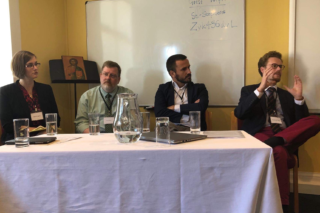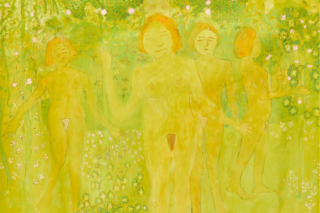This piece was originally published on Public Orthodoxy, a blog of the Orthodox Christian Studies Center of Fordham University. It is part of a series stemming from the ongoing research project “Contemporary Eastern Orthodox Identity and the Challenges of Pluralism and Sexual Diversity in a Secular Age," which is a joint venture by scholars from Fordham University’s Orthodox Christian Studies Center and the University of Exeter, funded by the British Council, Friends of the British Council, and the Henry Luce Foundation as part of the British Council’s “Bridging Voices” program. In August 2019, 55 scholars gathered for an international conference at St Stephen’s House, Oxford. The essays are summaries of presentations given in preparation for the conference and during it. They together reflect the genuine diversity of opinion that was represented at the conference and testify to the need for further reflection and dialogue on these complex and controversial topics.

When contemporary Orthodox discuss homosexuality, same-sex marriage, and gender more broadly, it's normally not long before someone quotes texts from the Genesis creation narratives:
So God created humankind in his image, in the image of God he created them; male and female he created them.
Therefore a man leaves his father and his mother and clings to his wife, and they become one flesh. (Gn 1:27, 2:24; NRSV)
Removed from their biblical and subsequent historical contexts, these verses become proof texts in support of gender essentialism, the idea that human beings exist in two sexes (male/female), with two genders (masculine/feminine), that result in two gender identities (man/woman). Gender essentialism asserts that these two sexes are complementary and emphasizes procreation (Gn 1:28) as a key element of their relationship.
Some contemporary Orthodox thinkers have taken this further, suggesting that male and female are modes of being in humanity in a way analogous to the modes of being in the Trinity. Just as the Son and the Spirit are the hands of the invisible Father in the world, so also male and female, taken together, express the image of God. Recently we have seen a claim of this type on Public Orthodoxy in an argument against same-sex marriage. (https://publicorthodoxy.org/2017/08/22/trinity-and-gay-marriage/)
Gender-essentialist interpretations of these Genesis passages are an exercise in question-begging: they assume that the essentialism modern readers point to is, indeed, a feature of the texts themselves. However, this is not the case. Our own culture is thoroughly permeated with essentialist and complementarian sensibilities. They're so much a part of our worldview that we do not notice that essentialism is only a lens through which we read the scriptures and the later patristic corpus. We tend to assume that biblical and patristic authors share our essentialist views. However, such essentialism was not a part of the worldview of the authors who produced these scriptures, the later generations that combined and preserved them, or many of the generations of Christians who have since read and exegeted them.
While most of us tend to think of male and female as opposites, ancient philosophical and medical thought had different models. In various Aristotelian, Hippocratic, and Galenic texts, men and women are not opposites. Rather, they are simply human beings on a continuum of greater to lesser perfection resulting from the quality of their parent's (or parents') seed and gestational conditions in the womb. Males were said to possess greater vital heat. This made them stronger, harder, warmer, and dryer. Females were thought to have less vital heat. Thus they were weaker, softer, cooler, and possessed more moisture. This continuum of bodily perfection was commonly thought to be mirrored in the moral capacities of the sexes. While patristic authors accepted these common cultural models of physical development, some argued that women are capable of cultivating the virtues just as men do. But the fathers and mothers of the church did not share our modern, essentialist interpretive lens.
Returning to the passages above, the priestly narrative of Genesis 1 is a polemical text, written in opposition to the Babylonian creation myth. In the Babylonian texts, only the king is created in the image of the god Marduk, who fashioned the world from the corpses of his defeated enemies. But in contrast, the priestly account asserts that God Elohim established the created order, bringing his work to completion by making and endowing all of humanity, men and women, with his image.
While essentialists often point to procreation as a key component of marriage, ascetical interpreters turn to allegory to interpret the divine command to "increase." Rather than children, Origen suggests that we should increase in good thoughts and inclinations. While battling the Manichees and their criticism of the sexual exploits of the patriarchs, Augustine follows Origen’s lead. (In his later career when his focus turns to other tasks, Augustine backs off Origen’s claim.) Other interpreters, such as John Chrysostom, suggest that God’s command was provisional, applicable when the newly created earth was barren, but that Christians no longer need produce children as an earthly legacy. Our differing contexts shape the lenses we bring to the texts.
The fathers also offer a variety of interpretations of Genesis 2:24 in the Yahwist narrative. In its Hebrew context, “one flesh” is used metaphorically to refer to a kinship bond. For Tertullian and Ambrose, following the gospel accounts of Jesus quoting this passage, the important aspect of this passage is a defense of the kinship bond against its dissolution in divorce. Augustine offers a Christological reading in which Christ leaves his heavenly Father and mother (the synagogue) to become one flesh with his wife (the church). Jerome and John Chrysostom take a different tack, suggesting the account is descriptive of the postlapsarian life. (Elsewhere, Chrysostom uses the passage to suggest that same-sex desire was introduced by the devil to incite war between the sexes.) Basil of Ancyra suggests that a virgin who leaves her father and mother will become "one flesh" with Christ the Bridegroom. Each patristic author offers a particular lens through which to view the passage, resulting in a different interpretation of the text.
So where did our gender-essentialist lens come from? A brief genealogy must include many sources. In Plato's Symposium, Aristophanes tells his companions that some human beings were originally androgynes that were split into men and women. These tragic figures go through life, seeking reunion with their other half. In Jewish Kabbalah, the Zohar asserts that male and female souls descend to earth in pairs, separate at birth, and reunite later in life as husband and wife. Drawing on these ideas, the Lutheran mystic Jakob Böhme suggests that the first human was an androgynous "youth-maiden" who split into male and female when his attention wandered from Virgin Sophia. These sources form the primordial soup that gives rise to the German-Romantic notion of two polarities, masculine and feminine, that continually attempt to unite in love as one. This Romantic legacy is the source of the gender essentialism and its complementarian readings that enter various streams of the Christian tradition—Orthodox, Roman Catholic, and Protestant.
Focusing on the Orthodox world, a novel reading of Genesis 1:27 appears at the turn of the twentieth century. Vladimir Soloviev, combining these various sources within his own religious philosophy, reads essentialist complementarity back into the priestly account, suggesting the image of God is found in the union of a spousal pair:
Eternal God created the human being, in his image and likeness created it: husband and wife, created them.
Fr. Sergius Bulgakov, inspired by Soloviev, uses these various sources to create a theological framework that suggests that the hypostasis of the Logos is the hypostasis of Christ, who is born and matures into the perfect man, while the hypostasis of the Holy Spirit is revealed in the Theotokos and then in the Church, the Bride of Christ. He goes on to suggest that all men share a hypostatic bond with the Son while all women share a hypostatic bond with the Spirit.
While Bulgakov's broader sophiological project fell into controversy, the ideas that only together do male and female express the image of God or of an association between women and the Holy Spirit on the one hand and men and the Son on the other continue in a line of Orthodox thinkers. These include Russian-diasporic lay theologians Pavel Evdokimov and Sergei Verkhovskoy. But perhaps most influential in this genealogy is Fr. Thomas Hopko, who promoted both ideas in his academic and popular writings.
Hopko's case illustrates another dynamic of our genealogy. Though himself an Orthodox theologian, Hopko appears to have been largely unaware of the ways in which his thought echoes Soloviev and Bulgakov. He instead acknowledges influence from Verkhovskoy, Vladimir Lossky, Fr. Alexander Schmemann, and a collection of Roman Catholic and Anglican authors. The same German-Romantic sources provide the basis for similar essentialist frameworks in Karl Barth’s Church Dogmatics, essays by Edith Stein and C. S. Lewis, and Pope John Paul II's Theology of the Body, to name but a few. With this in mind, it's easy to understand why converts to Orthodoxy from a variety of backgrounds often assume that essentialist thought is ubiquitous within the Christian tradition. But each of these streams, sometimes taking inspiration from each other, traces back to the same nineteenth-century origins.
With this historical development in mind, we are better positioned to see the essentialist/complementarian lens through which we so often interpret scripture and patristic texts. Gender essentialism is not a timeless element of the biblical and patristic tradition. Rather, it is a modern, German-Romantic amalgamation of a variety of sources, imported into various streams of Christian thought that are sometimes difficult to tease apart in our own time. Within contemporary Orthodoxy, gender essentialism is the fruit of both Russian religious thought of the last century and Orthodoxy's current dialogue with both Catholic and Protestant anthropologies inspired by the same Romantic sources. Knowing this makes it possible for us to consciously evaluate our essentialist/complementarian lens as our conversation continues.




